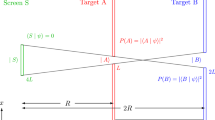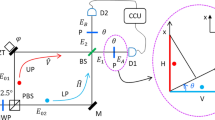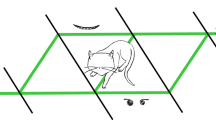Abstract
The principle of complementarity refers to the ability of quantum-mechanical entities to behave as particles or waves under different experimental conditions. For example, in the famous double-slit experiment, a single electron can apparently pass through both apertures simultaneously, forming an interference pattern. But if a ‘which-way’ detector is employed to determine the particle's path, the interference pattern is destroyed. This is usually explained in terms of Heisenberg's uncertainty principle, in which the acquisition of spatial information increases the uncertainty in the particle's momentum, thus destroying the interference. Here we report a which-way experiment in an atom interferometer in which the ‘back action’ of path detection on the atom's momentum is too small to explain the disappearance of the interference pattern. We attribute it instead to correlations between the which-way detector and the atomic motion, rather than to the uncertainty principle.
This is a preview of subscription content, access via your institution
Access options
Subscribe to this journal
Receive 51 print issues and online access
$199.00 per year
only $3.90 per issue
Buy this article
- Purchase on Springer Link
- Instant access to full article PDF
Prices may be subject to local taxes which are calculated during checkout




Similar content being viewed by others
References
Bohr, N. in Albert Einstein: Philosopher-Scientist (ed. Schilpp, P. A.) 200–241 (Library of Living Philosophers, Evanston, (1949)); reprinted in Quantum Theory and Measurement (eds Wheeler, J. A. & Zurek, W. H.) 9–49 (Princeton Univ. Press, (1983)).
Feynman, R., Leighton, R. & Sands, M. in The Feynman Lectures on Physics Vol. III, Ch. I (Addison Wesley, Reading, (1965)).
Scully, M. O., Englert, B. G. & Walther, H. Quantum optical tests of complementarity. Nature 351, 111–116 (1991).
Haroche, S. in High-resolution Laser Spectroscopy (ed. Shimoda, K.) 253–313 (Topics in Applied Physics, Vol. 13, Springer, (1976)).
Rauch, H. et al. Verification of coherent spinor rotation of fermions. Phys. Lett. A 54, 425–427 (1975).
Badurek, G., Rauch, H. & Tuppinger, D. Neutron interferometric double-resonance experiment. Phys. Rev. A 34, 2600–2608 (1986).
Storey, P., Tan, S., Collett, M. & Walls, D. Path detection and the uncertainty principle. Nature 367, 626–628 (1994).
Englert, B. G., Scully, M. O. & Walther, H. Complementarity and uncertainty. Nature 375, 367–368 (1995).
Storey, E. P., Tan, S. M., Collett, M. J. & Walls, D. F. Complementarity and uncertainty. Nature 375, 368 (1995).
Wiseman, H. & Harrison, F. Uncertainty over complementarity? Nature 377, 584 (1995).
Wiseman, H. M. et al. Nonlocal momentum transfer in welcher weg measurements. Phys. Rev. A 56, 55–75 (1997).
Eichmann, U. et al. Young's interference experiment with light scattered from two atoms. Phys. Rev. Lett. 70, 2359–2362 (1993).
Cohen-Tannoudji, C. Effect of non-resonant irradiation on atomic energy levels. Metrologia 13, 161–166 (1977); reprinted in Cohen-Tannoudji, C. Atoms in Electromagnetic Fields 343–348 (World Scientific, London, (1994)).
Kunze, S., Dürr, S. & Rempe, G. Bragg scattering of slow atoms from a standing light wave. Europhys. Lett. 34, 343–348 (1996).
Kunze, S. et al. Standing wave diffraction with a beam of slow atoms. J. Mod. Opt. 44, 1863–1881 (1997).
Bernhardt, A. F. & Shore, B. W. Coherent atomic deflection by resonant standing waves. Phys. Rev. A 23, 1290–1301 (1981).
Acknowledgements
We thank S. Kunze for discussions. This work was supported by the Deutsche Forschungsgemeinschaft.
Author information
Authors and Affiliations
Corresponding author
Rights and permissions
About this article
Cite this article
Dürr, S., Nonn, T. & Rempe, G. Origin of quantum-mechanical complementarity probed by a ‘which-way’ experiment in an atom interferometer. Nature 395, 33–37 (1998). https://doi.org/10.1038/25653
Received:
Accepted:
Issue Date:
DOI: https://doi.org/10.1038/25653
This article is cited by
-
Coherently driven quantum features using a linear optics-based polarization-basis control
Scientific Reports (2023)
-
Entanglement-interference complementarity and experimental demonstration in a superconducting circuit
npj Quantum Information (2023)
-
Observations of the delayed-choice quantum eraser using coherent photons
Scientific Reports (2023)
-
A possible solution to the which-way problem of quantum interference
Quantum Studies: Mathematics and Foundations (2023)
-
A Unified Explanation of Some Quantum Phenomena
International Journal of Theoretical Physics (2023)
Comments
By submitting a comment you agree to abide by our Terms and Community Guidelines. If you find something abusive or that does not comply with our terms or guidelines please flag it as inappropriate.



